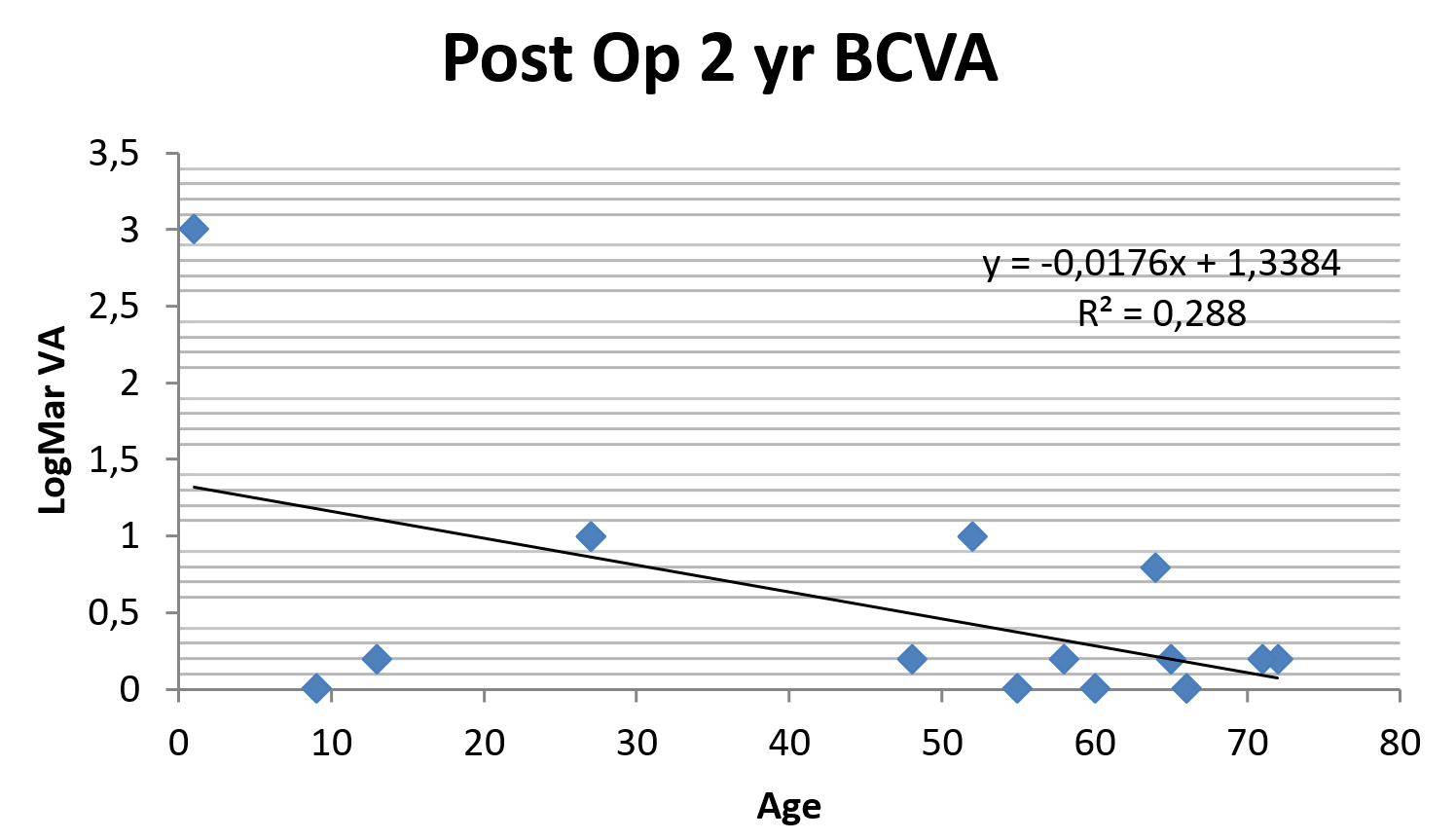Safety and efficacy of posterior iris claw intraocular lens fixation in aphakic patients
Abstract
Purpose: To assess the indications and visual outcome of eyes undergoing posterior iris fixated intraocular lens (IFIOL) implantation for aphakia, to identify reasons for poor visual outcome, and report occurrence of complications.
Methods: In this retrospective case series study, all cases of posterior IFIOL fixation performed over a 30-month period were identified retrospectively. Preoperative and postoperative evaluations comprised objective and subjective refraction, best corrected visual acuity (BCVA), slit lamp biomicroscopy, applanation tonometry, and dilated fundus examination.
Results: Fifty-six eyes of 56 patients were analyzed. Mean age was 60.55 ± 17.2 years. The most common indication for IFIOL implantation was surgical aphakia following complicated cataract surgery (n = 33; 58.9%) followed by trauma (n = 10; 17.9%), dropped nucleus/IOL during primary surgery (n = 6; 10.7%), and subluxated/dislocated lens-induced glaucomas (n = 5; 8.9%). BCVA better than or equal to their preoperative BCVA was achieved in 96.43% patients. The surgical aphakia and paediatric/adolescent groups had the best visual results while the dropped nucleus/IOL group and subluxated lens-induced glaucoma groups fared poorly. On the long-term follow-up visit, the most common complication noted was pigment dusting on the corneal endothelium (65.7%).
Conclusion: The long-term results suggest that posterior IFIOL implantation is a safe and effective method for correction of aphakia and can be used for a wide range of indications in eyes without adequate capsule support. It may be considered an easier and faster alternative with minimal manipulation to anterior segment structures in paediatric and post-traumatic aphakic eyes.
References
2009;93(10):1273-1275.
2. Sawada T, Kimura W, Kimura T, et al. Long-term follow-up of primary anterior chamber
intraocular lens implantation. J Cataract Refract Surg. 1998;24(11):1515-1520.
3. Kwong YY, Yuen HK, Lam RF, Lee VY, Rao SK, Lam DS. Comparison of outcomes of primary scleralfixated
versus primary anterior chamber intraocular lens implantation in complicated cataract
surgeries. Ophthalmology. 2007;114(1):80-85.
4. Bellucci R, Pucci V, Morselli S, Bonomi L. Secondary implantation of angle-supported anterior
chamber and scleral-fixated posterior chamber intraocular lenses. J Cataract Refract Surg.
1996;22(2):247-252.
5. Lett KS, Chaudhuri PR. Visual outcomes following Artisan aphakia iris claw lens implantation. Eye.
2011;25(1):73-76.
6. Koss MJ, Kohnen T. Intraocular architecture of secondary implanted anterior chamber iris-claw
lenses in aphakic eyes evaluated with anterior segment optical coherence tomography. Br J
Ophthalmol. 2009;93(10):1301-1306.
7. Baykara M, Ozcetin H, Yilmaz S, Timuçin ÖB. Posterior iris fixation of the iris-claw intraocular lens
implantation through a scleral tunnel incision. Am J Ophthalmol. 2007;144(4):586-591.
8. De Silva SR, Arun K, Anandan M, Glover N, Patel CK, Rosen P. Iris-claw intraocular lenses to correct
aphakia in the absence of capsule support. J Cataract Refract Surg. 2011;37(9):1667-1672.
9. Gonnermann J, Torun N, Klamann MK, et al. Visual outcomes and complications following
posterior iris-claw aphakic intraocular lens implantation combined with penetrating
keratoplasty. Graefes Arch Clin Exp Ophthalmol. 2013;251(4):1151-1156.
10. Bhandari V, Reddy JK, Karandikar S, Mishra I. Retro-pupillary iris fixated intraocular lens in
pediatric subluxated lens. Journal of Clinical Ophthalmology and Research. 2013;1(3):151.
11. Rao R, Sasidharan A. Iris claw intraocular lens: a viable option in monocular surgical aphakia.
Indian J Ophthalmol. 2013;61(2):74.
12. Gonnermann J, Torun N, Klamann MK, et al. Posterior iris-claw aphakic intraocular lens
implantation in children. Am J Ophthalmol. 2013;156(2):382-386.
13. Güell JL, Manero F. Artiflex (foldable iris claw IOL) secondary implantation for correction of
aphakia after penetrating ocular injury. J Refract Surg. 2004;20(3):282-283.
14. Odenthal MT, Sminia ML, Liesbeth JJ, Gortzak-Moorstein N, Völker-Dieben HJ. Long-term
follow-up of the corneal endothelium after artisan lens implantation for unilateral traumatic and
unilateral congenital cataract in children: two case series. Cornea. 2006;25(10):1173-1177.
15. Gicquel JJ, Guigou S, Bejjani RA, Briat B, Ellies P, Dighiero P. Ultrasound biomicroscopy study of
the Verisyse aphakic intraocular lens combined with penetrating keratoplasty in pseudophakic
bullous keratopathy. J Cataract Refract Surg. 2007;33(3):455-464.
16. Worst JG, Massaro RG, Ludwig HH. The introduction of an artificial lens into the eye using
Binkhorst’s technique. Ophthalmologica. 1972;164(5):387-391.
17. Mohr A, Hengerer F, Eckardt C. [Retropupillary fixation of the iris claw lens in aphakia. 1 year
outcome of a new implantation techniques]. Der Ophthalmologe: Zeitschrift der Deutschen
Ophthalmologischen Gesellschaft. 2002;99(7):580-583.
18. Menezo JL, Martinez MC, Cisneros AL. Iris-fixated Worst claw versus sulcus-fixated
posterior chamber lenses in the absence of capsular support. J Cataract Refract Surg.
1996;22(10):1476-1484.

Copyright (c) 2018 Asian Journal of Ophthalmology

This work is licensed under a Creative Commons Attribution 4.0 International License.
Authors who publish with this journal agree to the following terms:
- Authors retain copyright and grant the journal right of first publication, with the work twelve (12) months after publication simultaneously licensed under a Creative Commons Attribution License that allows others to share the work with an acknowledgement of the work's authorship and initial publication in this journal.
- Authors are able to enter into separate, additional contractual arrangements for the non-exclusive distribution of the journal's published version of the work (e.g., post it to an institutional repository or publish it in a book), with an acknowledgement of its initial publication in this journal.
- Authors are permitted and encouraged to post their work online (e.g., in institutional repositories or on their website) prior to and during the submission process, as it can lead to productive exchanges, as well as earlier and greater citation of published work (See The Effect of Open Access).


